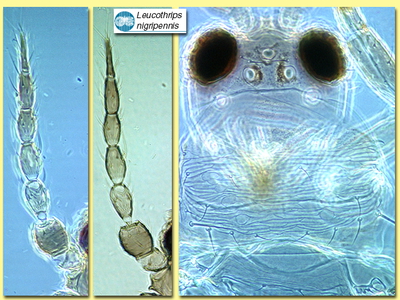Figures
Fig. 1 Antenna, head and pronotum
Fig. 2 Head, thorax with fore and hind wing and abdomen
Fig. 3 Pro-, meso- and metathorax with metathoracic furca
Fig. 4 Meso- and metathorax with typical furca
Fig. 5 Tergite IV and V
Species
Leucothrips nigripennis Reuter
Biology
Breeds on the fronds of several small cultivated ferns, particularly Pteris cretica.
Distribution
Widespread, but reported infrequently, in europe and North America; also known from southern India, Brazil, and Australia.
Recognition
Body white, antennal segment I white, II brown, III light brown but succeeding antennal segments increasingly dark; forewing uniformly dark brownish grey. Head with 2 pairs of ocellar setae, no postocular setae and no sculpture; maxillary palps 3-segmented. Antennae with 7 segments; sensoria on III & IV forked but asymmetric, VI & VII each with a long sensorium arising close to base. Pronotum with many transverse, finely craspedate, striae; posterior margin with 4 pairs of setae, the outer 2 pairs 1.2 to 1.5 times as long as the inner 2 pairs. Metanotum with closely set parallel lines medially, median pair of setae not at anterior margin. Forewing second vein with no setae, first vein with 2 setae on distal half of wing. Abdominal tergites II-VIII with one pair of long medial setae arising close together; tergite V with about 10 almost-parallel striae laterally, bearing very small tuberculate microtrichia; tergite VIII with complete marginal comb. Abdominal sternites II-VII each with 3 pairs of long marginal setae.
Related species
No other dendrothripine thrips, that is a member of the Thripidae with elongate lyre-shaped metathoracic endofurca, has dark forewings but a pale body. The other members of the genus are found in North and South America.






